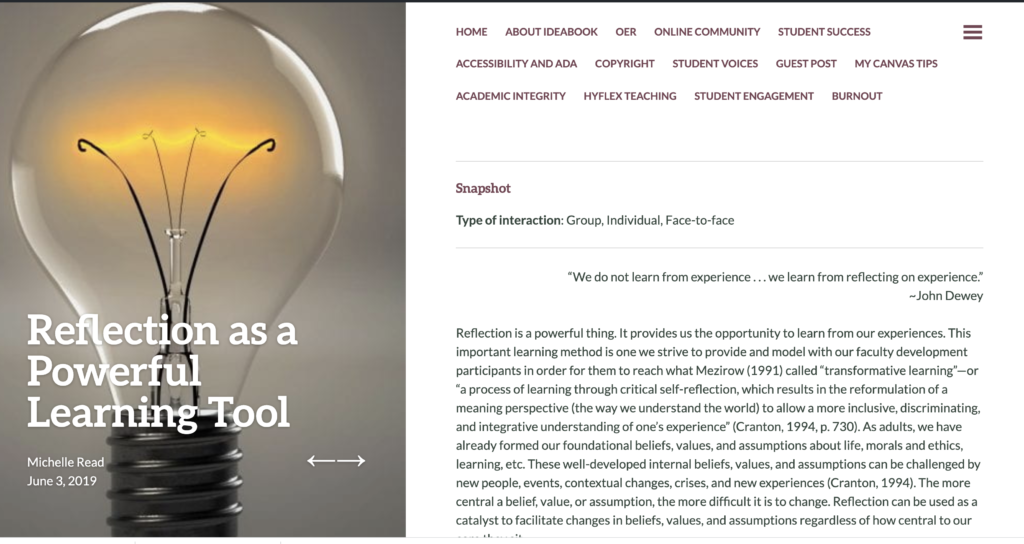One of my favorite quotes is from John Dewey – “We do not learn from experience…we learn from reflecting on experience.” This is why I always encourage and sometimes coerce my students to reflect on their learning. I encourage my faculty clients to do the same. In this ODEL IDeaBook post, I talk about the importance of reflection, reflection as part of the primary faculty development training we were providing at the time, and several ways to allow for reflection in any given course.

Snapshot
Type of interaction: Group, Individual, Face-to-face
“We do not learn from experience . . . we learn from reflecting on experience.”
~John Dewey
Reflection is a powerful thing. It provides us the opportunity to learn from our experiences. This important learning method is one we strive to provide and model with our faculty development participants in order for them to reach what Mezirow (1991) called “transformative learning”—or “a process of learning through critical self-reflection, which results in the reformulation of a meaning perspective (the way we understand the world) to allow a more inclusive, discriminating, and integrative understanding of one’s experience” (Cranton, 1994, p. 730). As adults, we have already formed our foundational beliefs, values, and assumptions about life, morals and ethics, learning, etc. These well-developed internal beliefs, values, and assumptions can be challenged by new people, events, contextual changes, crises, and new experiences (Cranton, 1994). The more central a belief, value, or assumption, the more difficult it is to change. Reflection can be used as a catalyst to facilitate changes in beliefs, values, and assumptions regardless of how central to our core they sit.
(More posts on Reflective Practice)
Reflection in Faculty Development
In our Foundations of/Advanced Online Course Design and Development faculty development course, we ask our participants to reflect on many topics. One important topic we reflect on includes new teaching methods and strategies aligned more with constructivist and socio-constructivist paradigms. Frequently, these new methods and strategies do not align with currently implemented teaching methods and strategies, which are often based on the faculty member’s current set of beliefs, values, and assumptions about the learning process. In this case, reflection in our course occurs mostly informally through discussions between participants and their instructional design consultant, in small groups with other faculty also facing new information and experiences, and in whole-group, reflective conversations.
Reflection opportunities for learners of all ages include:
- Individual, Pairs, and Whole Group (IPW) reflection. This is similar to reflection exercises we do in our faculty development in whole groups. A specified period of time is given for each step in the reflection: we start with (I)ndividual reflection, which is then discussed in (P)airs, and finally brought to the (W)hole group. For example, I=2 minutes; P=5 minutes, and W=10 minutes.
- What? So what? Now what? This popular reflection structure can be applied to oral and written reflection, individually, in pairs, or in groups. “What?” answers the descriptive aspects of what has been learned: facts, what happened, who, when, and where. “So what?” questions shift from descriptive to interpretive by answering why, interpreting meaning, and associating multi-perspective emotions or feelings. Finally, “Now what?” questions seek to place what has been learned into the larger picture or context, apply lessons learned to new situations, and/or create a plan or set goals, stating intentions for use in context.
- Surveys or questionnaires. Use questions that specifically illicit reflective responses. These will most often be open-ended. Consider providing sentence stems such as: “Today I learned . . .”, “I don’t understand . . .”, “The thing that surprised me today was . . .”, etc. See Higher Ed Professor for more. Ask extension questions for deeper reflection, such as “Why?” or “How?”.
- Journals or blogs. Journals are typically between the student and the instructor, while blogs might be read by other students. Students do not always know how to journal or blog in a truly reflective manner; thus, they may need to be taught explicitly how to do so (Muncy, 2014). Consider using metacognitive modeling to model the reflection process for your students. See Muncy’s article for reflective blogging (journaling) assignment considerations.
- Reflection videos. Have students reflect orally and submit as a video. These videos should be kept short, preferably in the range of 3-6 minutes. You could provide the same sentence stems from Higher Ed Professor.
- Video/document discussion. Use applications, such as Voicethread, to post a video of a performance or skill application (i.e. teaching a lesson, triaging a patient, etc.) and use time-stamped comments to reflect on what is seen/heard.
- Discussion forums. Encourage students to reflect and ask questions. Have students respond to each other by adding to those reflections and answering questions.
- One-minute papers. Check out OnCourse Workshop for some great prompts.
- Sketch reflections. Check out Derek Bruff’s blog for inspiration.
- Reflection snowballs. Everyone writes one key reflection, crumples their papers, tosses it to another student who reads it and adds to it.
This is a short, 10-item list of possibilities. Many more exist. Please check out the resources below or Google terms such as “reflection activities in higher education” to find many more.
Resources
Ahmed, Z. L., Hutter, L., and Plaut, J. (2008). Reflection in Higher Education Service-Learning. Scotss Valley, CA: Learn and Serve America’s National Service-Learning Clearinghouse, 2005/2008. Accessed 4/24/19 from: https://www.usf.edu/engagement/documents/reflection-in-he-sl-fs-short-sept08.pdf.
Huang, L. (2017). Three ideas for implementing learner reflection. Faculty Focus. Accessed 4/24/19 from: https://www.facultyfocus.com/articles/teaching-and-learning/three-ideas-implementing-learner-reflection/.
Whenham, T. (2019). 15 ways to spark student reflection in your college classroom. Nureva. Accessed 4/24/19 from: https://www.nureva.com/blog/education/15-ways-to-spark-student-reflection-in-your-classroom.